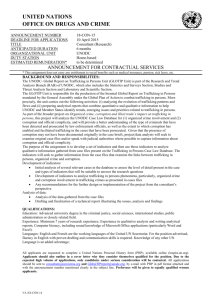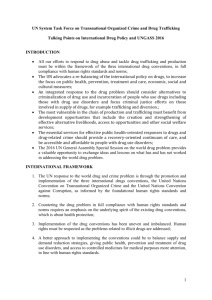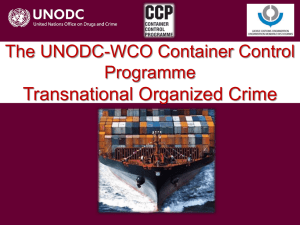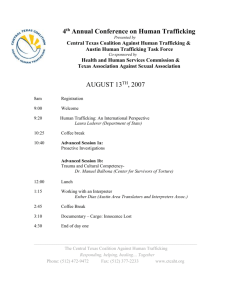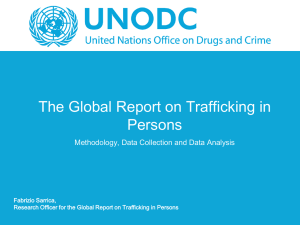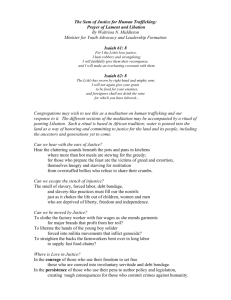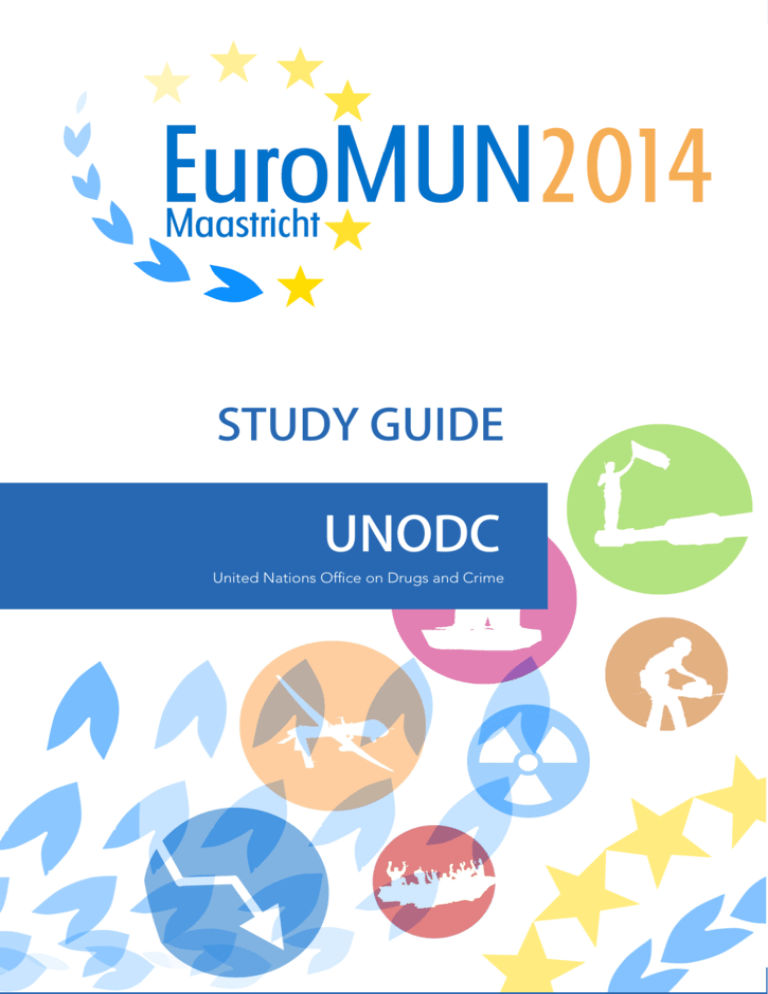
STUDY GUIDE
UNODC
United Nations Office on Drugs and Crime
1
Table of Contents
Word of Welcome
3
Committee Overview
4
Topic A: Human Trafficking
5
Topic B: Narco-terrorism
2
8
Word of Welcome
Matt Spencer
Hi, I am Matt and I have the honour of being your chair for the UNODC. I was the Deputy Sec-Gen of
Logistics for EuroMUN 2013 and was thrilled when they asked me to come out of retirement to chair
this year and know that it will build upon our foundations to be even better and more fun! I hope
that you all really enjoy our committee, learn lots about the very real issues that face the UNODC
and have a fantastic time in Maastricht!
See you all real soon,
Matthew Spencer
Giulia Spaggiari
I am currently enrolled in my final year of Law at the Catholic University of Milan, specializing in
International Law. I am very much looking forward to working with all of you in Maastricht!
3
Committee Overview
The United Nations Office on Drugs and Crime (UNODC) was established in 1997
with its headquarters are in Vienna. As UNODC’s primary objectives are assisting
member states in the combat against illicit drugs, crime and terrorism, being the global
leader in fighting drug trafficking and international crime (UNODC, 2014). With about
500 staff members and 21 field offices, the Office offers specialised assistance on:
- Organized crime and trafficking
- Corruption
- Crime prevention and criminal justice reform
- Drug abuse prevention and health
- Terrorism prevention
- Sustainable livelihoods
UNODC is formed by two main governing bodies: the Commission on Narcotic
Drugs (CND) and the Commission on Crime Prevention and Criminal Justice (CCPCJ).
UNODC was formed through a merger of many different UN agencies. However, the main
governing bodies, the Commission on Narcotic Drugs (CND) and the Commission on Crime
Prevention and Criminal Justice (CCPCJ), were kept unmodified6. Currently these two
committees are “functional committees” of Economic and Social Committee (ECOSOC).
Until 2011, they have held their meetings separately. , In order to inspect the
UNODC’s budgetary and programmatic activities, the two committees held their
first joint reconvened meeting on 12 December 2011, as advised by the ECOSOC7.
The agenda items of the two committees differ in accordance with their area of expertise. For
instance, CCPCJ deals with issues relating to crime prevention and criminal justice policy, including
trafficking of persons, transnational crime and terrorism prevention (Williams, 2008). Its primary
objectives are combatting national and transnational crime, including organized crime, economic
crime and money laundering, promoting the role of criminal law in protecting the environment, crime
prevention in urban areas, including juvenile crime and violence, and improving the efficiency and
fairness of criminal justice administration systems. In addition to these purposes, it also monitors the
use and application of relevant United Nations standards and norms, and guides policy development
in response to emerging forms of crime (UNODC, UNODC and Alternative development, 2014).
4
Topic A: Human trafficking
Nowadays, the human traffic is commonplace, to such a point that it represents one of the three the
most lucrative criminal activities of the world, after the illegal traffic of drugs and weapons (Ham,
2011). Human trafficking bases on human beings’ draft and on their exploitation by criminals with
the aim of gaining a financial profit from it. The victims can be forced or deceived with stratagems,
which leads them to prostitution, mendicancy, or manual labour. Human trafficking is thus an illegal
business of human beings, which enslaves every year more than two million people, half of whom are
children (Migration, 2012). 500 000 people are objects of trafficking in Europe every year, the majority
being women and girls forced to prostitute themselves. Their criminals, who make them glitter with
proposals of good jobs or studies, force them to prostitute themselves, earning a lot of money as a
result. These women undergo rapes and other physical and mental violence. The traffickers violate
the fundamental human rights of their victims, who lack their rights of free circulation, freedom of
choice, control over their body and spirit, control over their future. The traffic of humans is a complex
phenomenon, which is partially understandable by several internal and external factors: poverty, the
shortage of jobs, lower social status of the individuals, an overall lack of education , inadequacy of
the legislation in the concerned countries and the deficiencies of the mechanisms of application of
the laws (International, 2014). Human beings’ flow is a market of which the Thailand is one point, of
transit and destination. Thailand is one of the main hubs of transportation, also acting as a destination
(Truong, 2011). This business remains underestimated by the international community, because it
is a taboo subject that has not been mediatized enough. The various international organization
and special reporters of the United Nations for the defence of human rights do not arrive at a
consensus on a general definition of the terms “sale” and the “human trafficking” (Rudolph, 2012).
Who are the traffickers?
The traffickers are the ones who can recruit, transport, receive and exploit victims, oftenusing strength, threats, or other control mechanisms. Many traffickers belong to criminal
decentralized networks, rather than to professional criminal groups. The traffickers can operate
internationally as well as domestically. Often the traffickers and their victims share the same
nationality, allowing the traffickers to understand and exploit their victims (Affairs, 2010).
Sometimes the traffickers are themselves surviving victims, motivated by two main factors:
high profits and low risks. This combination is the basis of the explosive growth of human
trafficking, making the criminal industry one of the fastest growing ones in the world(ibid).
Who creates the demand?
Customers, who buy products and services, or people in the sex industry, create the demand (Ham,
2011). They could include the customers of the sex industry, the companies, which subcontract in illegal
workshops, and the consumers who buy cheap, forged goods.. At a global level, certain countries
are mainly conductors of forged people and thus act as agents of demand. The factors that motivate
them are the desire to take advantage of goods and services including cheap sexual services is on
the base of the demand, allied to an indifference in front of conditions of traffic of which the customer
5
takes advantage. Some customers are completely aware of the exploitation nature of their actions, as
many customers of the sex industry or the companies that subcontract in illegal workshops, whereas
others can have omitted to inquire about the source of the products they buy. In an international
context, certain countries can take advantage of a greater tax incomes, of fruits of the sex tourism,
or of other revenue streams associated in the exploitation of victims of the human trafficking inside
their borders (Trafficking in Numbers: The Social Construction of Human Trafficking Data, 2011).
Who are the victims of the trafficking?
The victims of the human trafficking often come from highly vulnerable populations, including
from poor people, from migrants, from runaway youngsters, from minorities or from oppressed
groups, from women and from children, and the victims of violence, from wars or from natural
disasters. In practice, there are obstacles that must be surmounted to make this strategy a success.
These include corruption, the lack of resources and the fact that human trafficking is a question
of low priority for law enforcement (Crime, 2012). However, the reform of the judicial system or
the political pressure are maybe more realistic than the eradication of the demand which makes
roll the industry or the elimination of the conditions of vulnerability to the human traffic of whole
populations. Such a system can increase the risks for the traffickers, but it can be compensated, at
least partially, with the valuable increase the profits (Ham, 2011). For that reason, a strategy which
aims at the traffickers should be accompanied by aggressive tactics aiming to reduce the demand.
Points a Resolution Must Address
- The means and methods related to the increase of cooperation among states with regard
to problems at hand.
- (Re)defining and enhancing the role of IGOs, NGOs, the media, and the like.
- Improving the effectiveness of national law enforcement at individual state level.
- Complete ratification of the already existing conventions and treaties on this very matter of
human trafficking.
- Rendering treaty processing and making more effective.
- Drawing further international attention to challenges posed by the issue of human
trafficking.
- Remedies for combating the turbulent situations faced by victims of human trafficking.
- Raising public awareness and supporting the pre-existing communities together with their
existent efforts.
- Building and consolidating collaboration between nations to work on the matter.
- Setting forth measures to be taken by states at the international level and at the regional
levels respectively specified in the study-guide.
- Repairing errors occurred in previous attempts to combat human trafficking so as to progress
toward firmer success.
6
Bibliography
Affairs, D.-G. o. (2010). Research based on case studies of victims of trafficking in human beings.
Brussels, Belgium : Commission of the European Communities.
Center, S. (2011, 04 26). Causes of Human Trafficking . Retrieved from AEC.CIO: http://www.
solidaritycenter.org/files/IndoTraffickingFactSheetCauses.pdf
Crime, U. N. (2012). Global Report on Trafficking in Persons. Vienna, Austria : United Nations.
Ham, J. (2011). What’s the Cost of a Rumor? “A guide to sorting out the myths and the facts about
sporting events and trafficking” . Bangkok, Thailand: Suphattra Poonneam.
International, A.-S. (2014, 02 28). What is Trafficking in People? Retrieved from Anti-Slavery
Today’s Fight For Tomorrow’s Freedom : http://www.antislavery.org/english/slavery_today/
trafficking.aspx
Migration, I. O. (2012). IOM 2011 Case Data on Human Trafficking: Global Figures and Trends.
Geneva, Switzerland: International .
Rudolph, A. (2012). Human Trafficking - Research and Measurement . Universität Heidelberg.
Trafficking in Numbers: The Social Construction of Human Trafficking Data. (2011). In D. A.
Feingold, Sex, Drugs, and Body Counts: The Politics of Numbers in Global Crime and
Conflict. Ithaca: Cornell University Press.
Truong, T.-D. (2011). `Human Trafficking and Organized Crime. Institute of Social Studies, The
Hague.
UNODC. (2014, 02 28). About UNODC. Retrieved from United Nations Office on Drugs and Crime
: http://www.unodc.org/unodc/en/about-unodc/index.html?ref=menutop
UNODC. (2014, 02 28). UNODC and Alternative development. Retrieved from United Nations
Officer on Drugs and Crime: http://www.unodc.org/unodc/en/alternative-development/
index.html?ref=menuside
Williams, R. (2008). Brritish-born teenagers being trafficked for sexual exploitation within UK,
police say. The Guardian, 1-3.
7
Topic B: Narco-terrorism
The first known Narco-terrorist organization, in Arabic, the Hashshashins, got their name
from their ritual of using hashish. Their first grand master, Hasan ibn-al-Sabbah, indoctrinated his
followers to become political assassins who would frequently conduct suicide missions (Durnagol
2009). His recruits where so successful in their missions, that the word “assassins” became part
of our vocabulary. The term “Narco-terrorist” became known in the 1980s in Colombia and Peru.
Peruvian President Belaunde Terry used the term in 1983 in reference to terrorist attacks that
influenced his anti-narcotics policies (ibid). Notorious narco-terrorist, Pablo Escobar, head of the
Medellin Cartel, waged a war against the Colombian government through the assassinations of
judges, kidnapping and intimidation of the Colombian population, while working his way up into
the administration. His ultimate goal was to shape the country’s policies according to his views; he
even managed to force a revision on the extradition treaty Colombia had with the USA (Durbin 2013).
The US first recognized the term during the Cold War, using it to describe the USSR’s
involvement in illegal drug trade (Haupt 2009). Yet the concept of narco-terrorism entails more
than that nowadays, and it will be analyzed to lager extent in the following paragraphs. It
is crucial to have a clear contemporary understanding of this term , in order to define clear
effective policies to counter a rapidly evolving multi-facet problem. The EuroMUN UNODC
committee will have to have a good knowledge of the concept and its impact all over the
globe to be able to offer comprehensive and applicable alternative policies to solve this issue.
Narco-terrorism, according to the US Drug Enforcement Agency, refers to the “participation
of groups or associated individuals in taxing, providing security for, otherwise aiding or abetting drug
trafficking endeavors in an effort to further, or fund, terrorist activities” (Holmberg, 2009).There is hence
a dual character to this concept; a distinction is necessary between its ‘drug’ aspects and ‘terrorist’
aspect (Bjornehed 2006). In today’s world, globalization offered enormous growth opportunity for
any form of organizations. Drug trafficking organizations (DTOs) and violent extremist organizations
(VEOs), grasped this opportunity to develop cooperation and share competences at the international
level, in order to promote and secure their agenda. DTOs and VEOs evolved towards one another
as globalization began in the 1990s, then changed their nature to have “two separate phenomena
reveal many operational and organizational similarities” according to Tamara Makarenko (Holmberg
2009). Makarenko established a crime-terror nexus depicting the growing similarities and interaction
between DTOs and VEOs. Her model depicts organized crime and terrorism converging towards
each other since the 1990s, into what is referred to as a black hole. The first phase of the model is the
establishment of the alliances. Second is the operational motivation; DTOs would employ terrorist
tactics, while VEOs would conduct organized crime activities. The convergence towards the socalled black holes depicts where DTOs and VEOs converge, where the distinction between legal and
illegal becomes blurred and therefore allows them to profit from that situation (Durnagol, 2009). The
convergence can explain why some DTOs and VEOs evolved. It is crucial to understand this interaction
to formulate future policies. Narco-terrorist organizations have increasingly acquired rapid means to
respond to evolving legislations at the national and international level to counter measures by law
8
enforcement. A supranational response is required to tackle this problem from every angle possible.
State building and sovereignty are challenged by narco-terrorism. Among the pervasive effect
of drug trafficking on states are the health related issues, the societal matters and the related violence.
These have enormous costs for states’ budgets and especially for developing states, the instability
and hindrance of state building associated with drug trafficking are rather worrying. Engin Durnagol,
deputy director general for Personnel Affairs in the Turkish Ministry of Justice, talking about “the
role of drugs in terrorism and organized crime” depicts five ways drug trafficking benefits terrorism.
These are:
1) Funds for terrorism,
2) Chaos where drugs are present, sometime fostered by DTOs and VEOs to create a
favorable environment for them,
3) Corruptions of public institutions with probably the intention to initiate support for
terrorist organization,
4) Logistical support for DTOs and VEOs,
5) Challenges law enforcement and intelligence agency.
All these factors make it a complex multi-dimensional issue that requires an approach at the
national, regional and international level. Drug trafficking creates tension at different levels of the
states and even beyond borders. The biggest producer of heroin remains Afghanistan according
to the UNODC 2013 World drug report; the report also notes that the demand for opiates in South
East Asia will not be covered by its traditional supplier, i.e Burma and Laos. The current political
situation in those countries mention previously explains why they are world-class producers.
Poverty and weak governments favor the growing of illegal crop; the failure of the government
to respond to basic needs make space for VEOs or DTOs to become substitutes. They can offer
protection and shelter, basic access to water or health care. They come in and fill in the void. The
Taliban played that role in Afghanistan; the production of opium and cannabis respond to the
basic needs of survival of the poor population, facilitating their establishment as the de facto
government.
The situation in Mexico clearly shows how narco-terrorism can destabilize a country. The
symptoms were known, increasing drug production along and widespread abused of it, drug
related crime, threats to public safety and health, corruption along with money laundering and
the infiltration of the government and economy (Haupt 2009). The Sinalao Drug Cartel, one of the
most powerful drug cartel in the world, began as a group of local farmer families growing marijuana
and opiates. They operate by establishing alliances, relying of their network and preferring the
diplomatic situation rather than violence (Durbin 2013). Their current leader is listed by Forbes
as the 67th most powerful individual. The Sinalao cartel has the logistic capabilities to smuggle
anything into the US and is present in West Africa, Eastern and Western Europe, conducting its
affairs with the Mara Salvaltrucha, commonly known as MS13, a transnational criminal organization.
To recruit, they have a very advantageous welcoming package including well-paid jobs and health
care while funding local government and political parties. Many hence believe that Mexico has
9
become a narco state.. Additionally, there is proof today of al-Qaeda links with Latin America’s
VEOs but no evidence of ties with DTOs in Central and South America has been shown.
Certain terrorist organizations use drugs or drug trafficking to disrupt the very basis of
society, believing that the consumption of drugs can weaken the enemy; this rhetoric allows them
to justify themselves towards their supporters and is particularly aimed towards industrial societies
by encouraging drug addictions via their activities and generating revenue for their ongoing
activities. The UNODC 2013 world drug reports estimates drug related deaths to be around
211.000, mostly among the youth; this could have been prevented. The latest data shows that a
rapid decline in the number of people injecting drugs and living with HIV. For more data, it is highly
suggested to familiarize yourselves with the Word Drug Report; this facilitates an understanding
of the evolution of drug consumption and potential future trends. It is estimated that 11.5% of
individuals who inject drugs have HIV these numbers have been reviewed and the decline can
be explained by more reliable data collected worldwide. Russia, China and the USA account for
46% of the global number of people who inject drugs with HIV. Europe accounts for 13%. Another
disease among people who inject drugs is Hepatitis C, namely 51% according to UNODC.. Illegal
drugs create enormous public health issues and require funds for drug treatment. The upcoming
challenge this committee will have to address is the emergence of new psychoactive substance,
which is constantly evolving and generating revenues for organized crime and potentially terrorist
organizations. The UNODC has proposed an international framework to allow countries to rapidly
identify new psychoactive substances and share this information to counter their effects, as well
asfor public health safety purposes. If narco-terrorism aims to shatter the foundations of our civil
societies, it can be said that they are successful in sustaining and worsening the public health system.
As stated previously, VEOs like al-Qaeda, the PKK or LTTE are nowadays connected to DTOs
and benefit from the synergy of globalization. The Taliban receive funds from drug trafficking and
use these to finance their operations. Furthermore, they gather local support as they protect local
producers from retribution for their illegal activities. It is estimated that al-Qaeda receives millions
annually via the Taliban, which have institutionalized the taxation of heroin by giving receipts for tax
payment. Al-Qaeda even developed ties with Mexican DTOs in order to obtain logistical support for
easier access to the US (Durbin 2013). The Hezbollah’s expertize in tunnel building was also found
in the tunnel from Mexico to the USA (ibid). IEDs once only found in the Middle East are nowadays
found in Mexico. The MI6 established links between al-Qaeda and the FARC, the Shinning Path,
Mexico’s Popular Revolutionary army and other Mexican DTOs (Haupt, 2009). VEOs like Hezbollah, alQaeda fit into Makarenko’s Crime-Terror nexus. Such complexity requires international cooperation
between law enforcement agencies, training foreign policing forces in various fields, as well as sharing
knowledge and competences.. Measures must be taken to respond to the direct threat; anti-corruption
measures, freezing financial assets and foreign aids can influence policies to counter narco-terrorism.
The Euromun UNODC committee will have to come up
policies
to
respond
to
the
evolving
threats
posed
by
10
with concrete
narco-terrorism.
Bibliography (Recommended readings)
Bjornehed, Emma. Narco-Terrorism: The Merger of War on Drugs and the War on Terror. Global Crime. 6:3-4. 305-324/ Maastricht University library.
Durnagol, Engin. The Role of Drugs in Terrorism and Organized Crime. Ankara review. 2009.
Durbin, Kirk J. International Narco-Terrorism and Non-State Actors: The Drug Cartel Global Threat. Global Security Studies. Winter 2013. Vol 4. Issue 1. Norwish University.
Haupt, David A, Lt Col. Narco-Terrorism: An increasing threat to US National Security.
Holmberg, John. Narcoterrorism. PUBP 710. Terrorism, transnational crime and corruption center. George Mason University. May 2009.
USAF. Joint Force Staff college. Norfolk. 2009.
UNODC. The World Drug Report 2013.
11
This guide is provided to help delegates prepare for their respective committees at EuroMUN. No rights may be derived from the information provided in this document, for any questions please contact your chair or the
EuroMUN Staff at information@euromun.org .
©2014 - All Rights reserved.
12

